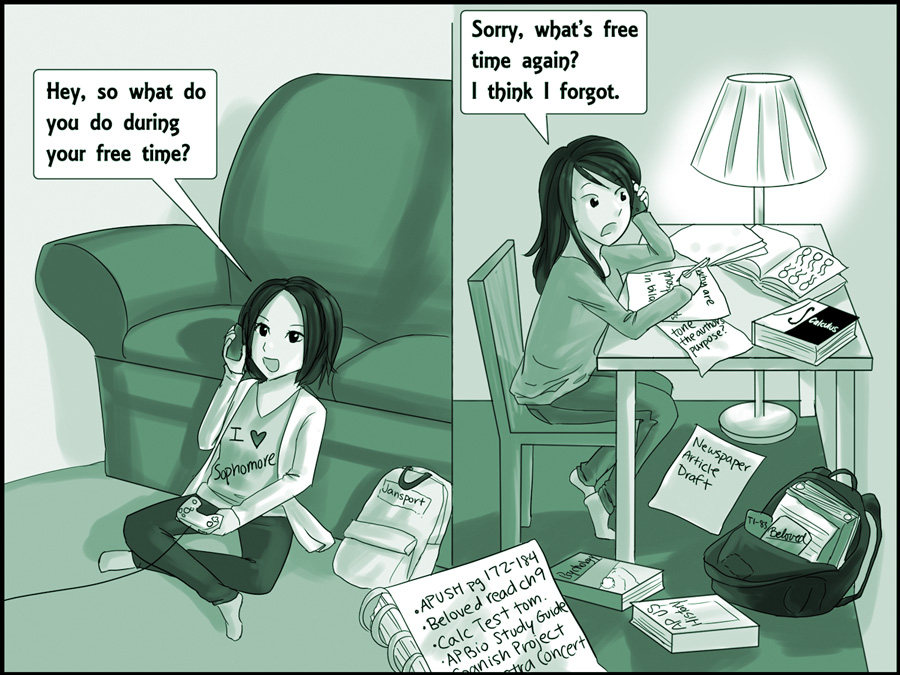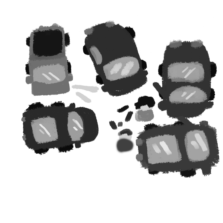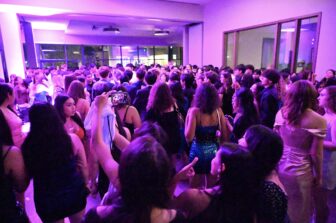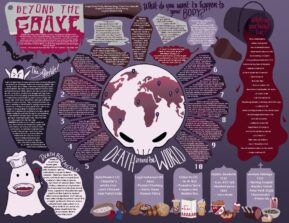

The Aragon Outlook is concerned that there appears to be a large discrepancy between the workload and general difficulty of courses during freshman and sophomore years compared to that of junior and senior years. The first two years of high school are intended to transition students from middle school, while concurrently preparing them to take on more difficult work in later years. However, the gap between sophomore and junior year indicates that this goal is not being fulfilled; while some students make the transition with minimal struggle or adjustment, many students enter their junior year unprepared for the difficulty and time commitment that their classes require.
Frontloading for the future
At Aragon, students follow a four-year educational path designed by teachers and counselors that is intended to prepare students in continuing their education at two-year or four-year colleges. Unbeknownst to most, this preparation begins in large part during freshman and sophomore years. Aragon currently offers Advanced Standing (AS) classes in the English and History departments, which teach and empower students to practice the skills necessary to succeed later on in more challenging courses. Going into freshman year, math and foreign language courses are usually determined by individual students’ progress in middle school, and going into senior year, decisions typically reflect success from earlier high school years.
Critical thinking, argument organization, effective presentation: these skills, as well as the ever-present question of “Why does this matter?” facilitate the transition to a high school education which is accessible to all types of students. Yet in recognizing the chasm yawning between advanced sophomore and junior classes, the Outlook asks teachers, “Is there an equitable solution for all students?”
In considering the status quo, the gap between sophomore and junior years does not affect everyone equally. Some students take the escalation in stride while others struggle greatly. Ultimately, the common caricature of the overstressed junior is far too accurate: too many students find themselves overwhelmed at the beginning of junior year.
Arguably, not enough learning occurs in the early years of high school, giving rise to too much too late and a missed opportunity. This creates junior and senior years that are harmful to students’ well-being and even detract from effective learning.
Thus, in returning to the idea that freshman and sophomore year offer an opportunity for students to orient themselves to higher level courses, perhaps a shift in paradigm could serve to reduce and reconcile said gap. Transfer the onus of transition to freshman year, leaving sophomore year more open to focus on developing the tools necessary and applicable to a more global context.
In part, this issue could be ameliorated by frontloading certain components of the AP curriculum to the preceding year. For example, Precalculus 1-2 concludes with an introduction to limits and derivatives. Both topics are integral to Calculi AB and BC, courses which often follow a year of Precalculus.
Similarly, English 3-4 could integrate novel material that is a part of the AP English Language and Composition course. Sophomore students could be introduced to writing “chunks”—brief style analysis pieces—in preparation for the English course offered the subsequent year, regardless of whether students choose to pursue AP or not.
We recognize that students will ultimately be held accountable to a higher and more difficult level of learning than current students face during freshmen and sophomore years. Yet, accordingly, The Outlook puts forth such a shift with the hopes that it will, not only better prepare students to navigate the sophomore-junior gap, but also enable students to be stronger academics overall.
Informing for an improved decision process
In a separate sense, while students’ stress may be self-inflicted due to their choice to take so many AP classes, it is too often a result of their ill-informed decision when it comes to class selection. This is currently a weakness of the system at Aragon; students are not made sufficiently aware of how difficult AP and honors classes can potentially be.
Before signing up to take AP classes, students are required to meet with their counselors and attend a meeting given to prospective students by the teacher of an AP course. Neither of these effectively prevent students from overloading their class loads for the following year.
While counselors and current teachers could continue to work hard to alert students of the difficulty of the classes, Aragon could to educate students past simple warnings; in the Outlook’s opinion, warnings of strenuous homework loads and challenging curriculums do little to discourage students from loading up on AP classes.
Nowhere else are these ineffective warnings more evident than in the meetings AP teachers hold for prospective students. A primary objective of these meetings is to alert incoming students of what should be expected of them. But while teachers and former students do warn prospective students of the difficulties that face them, it is too often that these meetings turn into opportunities for teachers to “sell” their class; rarely does one hear a teacher advise students against taking their class as AP teachers seek to maintain or increase the amount of students in their classes. While this inclination is perfectly understandable, it holds the potential to harmfully misinform students of the difficulty of a class.
In order to improve the underclassmen’s lack of understanding and foresight when it comes to AP classes, multiple opportunities for them to observe and participate in an AP courseload could be offered to them before they enter their junior and senior years.
This could be provided in a variety of ways. AP teachers could offer sample homework calendars to prospective students in order to expose them to the amount of work due in a typical week. Teachers could also give prospective students actual homework that they would receive in class to expose them to the quality and quantity of work that would be expected from them.
Students and their parents could also have the opportunity to observe an AP class in full swing; as of now, Open House does not provide a satisfactory example of the type of work students are doing in a class—all too often, teachers show off art and other types of visual projects to entertain parents and students. If Open House could become an opportunity for teachers to show parents and prospective students actual examples of work that AP students are currently working on and examples of typical homework and classwork assignments, parents and students would be much better informed of what awaits a student enrolling in a given AP class.
While it appears that an overstressed latter half of high school has become the norm, with a few simple implementations, Aragon could do a lot more to prepare its student body for the rigors of junior and senior year. It would be extremely beneficial to current underclassmen, now and in the future, to know exactly what they are signing up for. As too many sleep-deprived juniors and seniors can attest, the jump between sophomore and junior year is no walk in the park—students should be informed enough to mind the gap.






